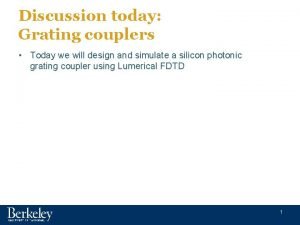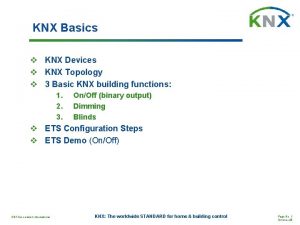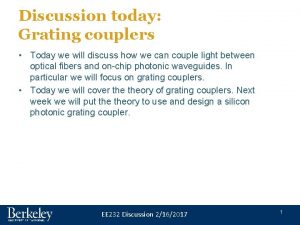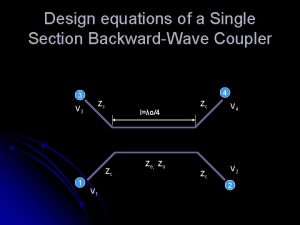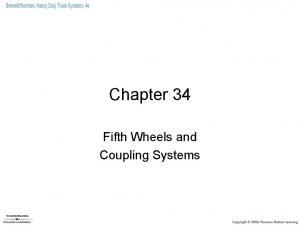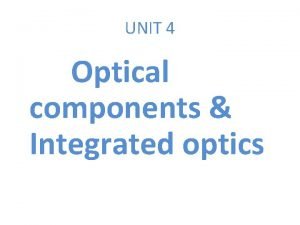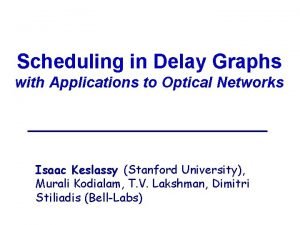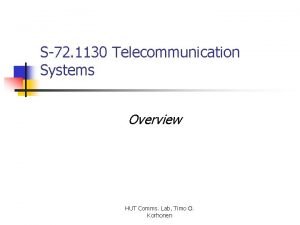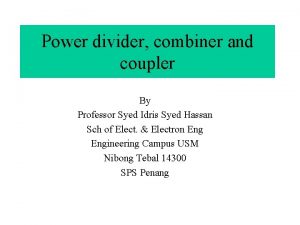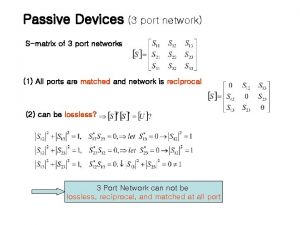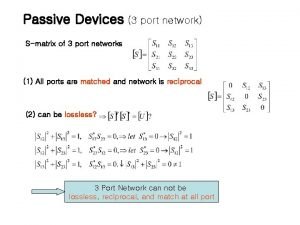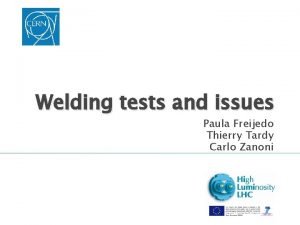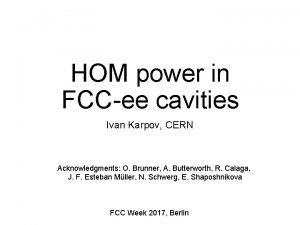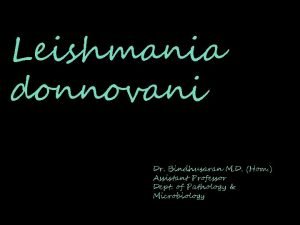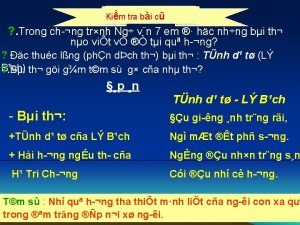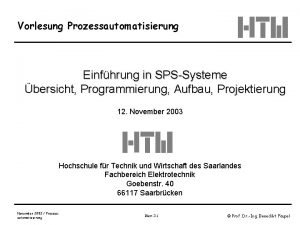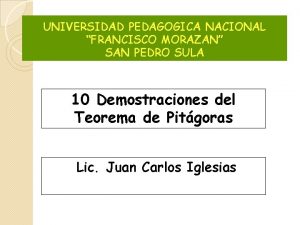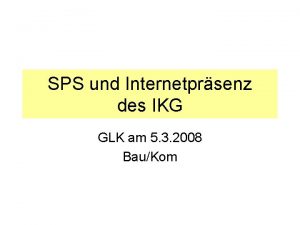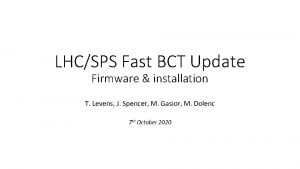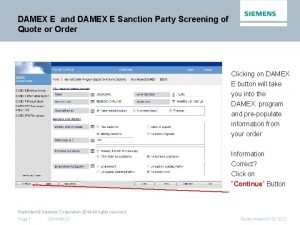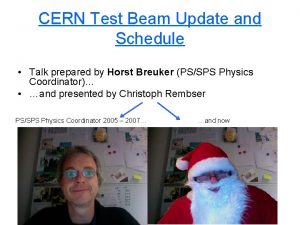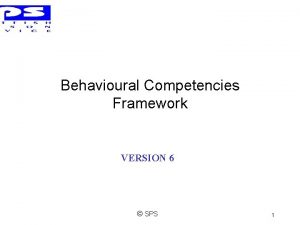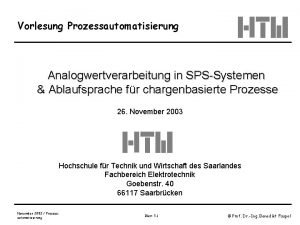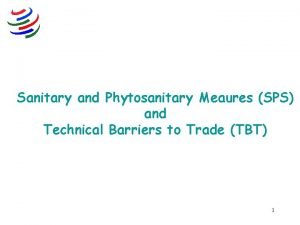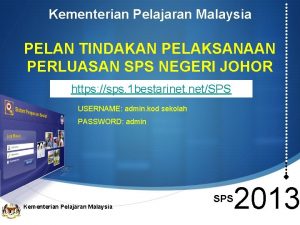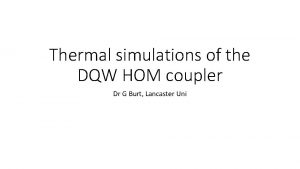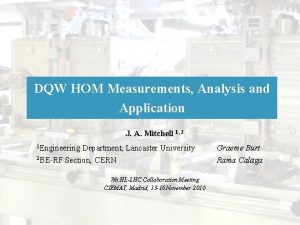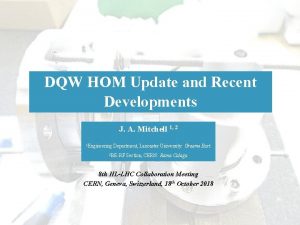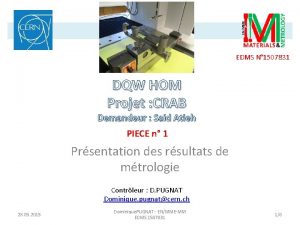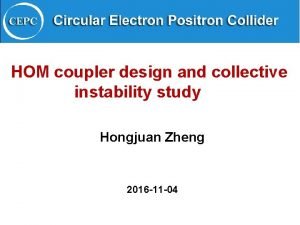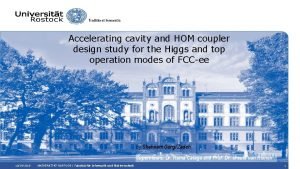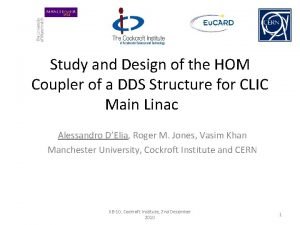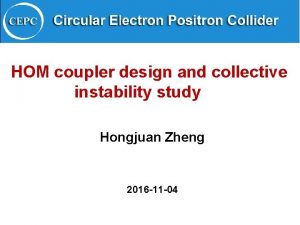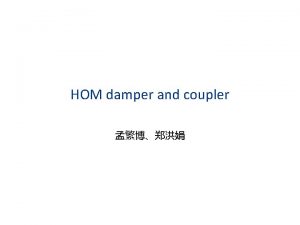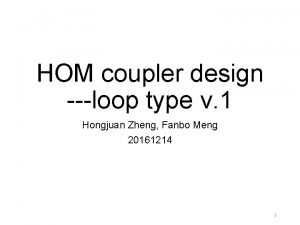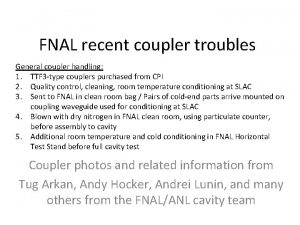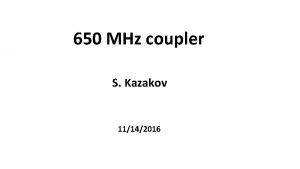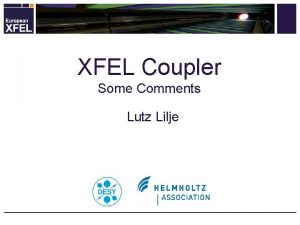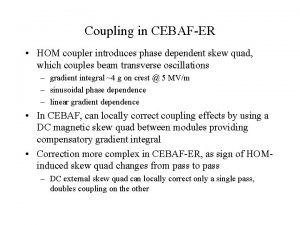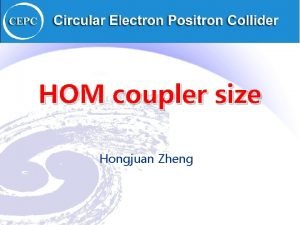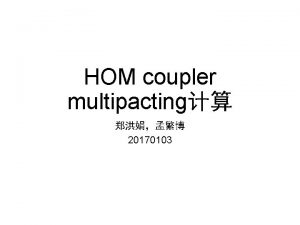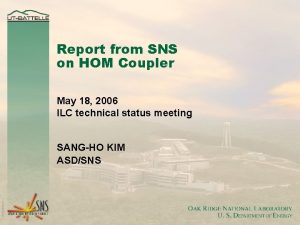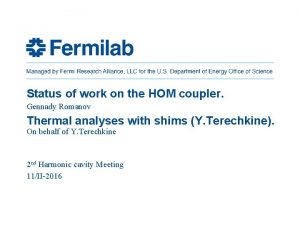HLLHC DQW HOM Coupler Design and SPS Measurements


![HL-LHC Number of particle-particle collisions. LHC Peak Luminosity [cm-2 s-1] Integrated Luminosity [fb-1] • HL-LHC Number of particle-particle collisions. LHC Peak Luminosity [cm-2 s-1] Integrated Luminosity [fb-1] •](https://slidetodoc.com/presentation_image_h/1e3c486f130fc6e69366dcc7577fd8f7/image-3.jpg)















![Meas. with Beam: Single Bunch 27/08/2018: MD 4 Mode [MHz] Top HOM Coupler Bottom Meas. with Beam: Single Bunch 27/08/2018: MD 4 Mode [MHz] Top HOM Coupler Bottom](https://slidetodoc.com/presentation_image_h/1e3c486f130fc6e69366dcc7577fd8f7/image-19.jpg)





















- Slides: 40

HL-LHC DQW HOM Coupler Design and SPS Measurements J. A. Mitchell Lancaster University and CERN 2 nd October 2018, Cornell University ICFA Mini Workshop on Higher Order Modes in Superconducting Cavities (HOMSC 2018)

Outline Hi. Lumi LHC HOM Ancillaries SPS Test Stand Pre. Installation HOM Coupler Evolution Beam Concs. 2
![HLLHC Number of particleparticle collisions LHC Peak Luminosity cm2 s1 Integrated Luminosity fb1 HL-LHC Number of particle-particle collisions. LHC Peak Luminosity [cm-2 s-1] Integrated Luminosity [fb-1] •](https://slidetodoc.com/presentation_image_h/1e3c486f130fc6e69366dcc7577fd8f7/image-3.jpg)
HL-LHC Number of particle-particle collisions. LHC Peak Luminosity [cm-2 s-1] Integrated Luminosity [fb-1] • • HL-LHC 1 x 1034 5 x 1034 40 250 HL upgrades increase the crossing angle – acts to reduce luminosity! To reduce the crossing angle: superconducting RF crab cavities. Hi. Lumi LHC 3

Crab Cavities for HL-LHC Double Quarter Wave (DQW) Vertical Crabbing Hi. Lumi LHC Radio Frequency Dipole (RFD) Horizontal Crabbing • • TEM Structures 400 MHz Dipole mode No LOMs 4

DQW Crab Cavity Purpose: Rotate proton bunch. Operation • • • 400 MHz deflecting mode. Superconducting Niobium (2 K Operation). Dipole mode. Field is only E-Field Kick voltage is actually combination of E and H. Hi. Lumi LHC 5

DQW HOM Coupler Vacuum model Niobium Conductively cooled by superfluid L-He (2 K) HOM Ancillaries Operation: • Hook-type coupling (electric and magnetic). • Demountable. • High-pass filter response. • LC band-stop filter. • Capacitively coupled output. • Broadens notch. • No moment on window. 6

DQW HOMC: Design Advantages 1. Gasket heating Gasket location • The LC band-stop is before the gasket. • This acts like an electrical short. • Very little dynamic heat load on the copper gasket (~ m. W)! • CRYOMODULE HAS DYNAMIC HEAT LOAD LIMIT (~ 20 W). Beam 2. Window location • Window is perpendicular to charged particles ejected from beam. • WINDOW BREAKS CRYOMODULE DOWN! HOM Ancillaries 7

Field Probe as Fourth HOM coupler • • • The pick-up is designed extract 1 W at the fundamental mode frequency Qe = 1. 6 x 1010. It is also a HOM coupler for the 1. 75 GHz mode cannot couple to this mode with HOM couplers. The PU is made from Nb and Cu to avoid heating. HOM Ancillaries 8

SPS Crab Test Stand Field probe Tuner HOM Couplers (x 3) FPC DQW crab cavity (vertical) Helium Vessel Cold magnetic shielding SPS Test Stand 9

Mode Measurements • Transmission measurements using VNA in cryomodule cold test in M 7 bunker. Pre-Installation 10

Mode Measurements • Transmission measurements using VNA in cryomodule cold test in M 7 bunker. Pre-Installation 11

HOM Power • Using SPS HOM coupler and HL-LHC parameters: • • However, the frequency and Qe of the modes can change. Stochastically varying these two parameters, a worst-case power can be calculated. 13 times larger than 1 k. W limit. Due to mode at 960 MHz – coupler needs to be altered. HOM Coupler Evolution 12

SPS HOM Coupler Development • The coupler should be altered to: 1. Reduce transverse impedance below threshold. 2. Reduce maximum foreseeable HOM power to below 1 k. W. 3. Improve ease of manufacture. HOM Coupler Evolution 13

SPS HOM Coupler Development • The coupler should be altered to: 1. Reduce transverse impedance below threshold. 2. Reduce maximum foreseeable HOM power to below 1 k. W. 3. Improve ease of manufacture. Issue Solution Machining time for circular crosssection. Rectangular crosssection. Difficult to EBWeld on curved surface. Flat section on capacitive jacket. Wasted Material: Perpendicular coax line is ‘flush’ with coupler base. HOM Coupler Evolution Lift output line. 14

DQW HOMC V 2 • • HOM Coupler Evolution 1. 2. 3. Flat section on capacitive jacket. Square profile throughout. Lifted output line for extruded ‘can’. Highest power still a result of the 960 MHz mode. If we vary this mode in frequency: 15

Modified Impedance Spectra • Impedance spectra: • Frequencies and Qe values are known for a large number of modes. • Simulated spectra altered for both cavities. • Note, remembering to use the +5 mm simulation results! • • • Beam For both cavities the 960 MHz mode has increased in frequency. From BELOW to ABOVE the harmonic! This shows it is feasible for the mode to be excited by the 24 th harmonic at 25 ns bunch spacing. 16

Measurements with Beam • • Measurement aims: 1. Validate we can predict HOM power accurately. 2. Validate we have not ‘missed modes’ in simulation. 3. Validate power increases with intensity (and bunch number) as expected. A binomial distribution was initially used to represent the bunch profile. H 1 H 2 H 3 Beam 17

Meas. with Beam: Single Bunch Cavity 1 - HOMC 1 27/08/2018: MD 4 Cavity 2 - HOMC 1 • • Beam Analytic underestimates Unforeseen power at 1. 8 GHz 18
![Meas with Beam Single Bunch 27082018 MD 4 Mode MHz Top HOM Coupler Bottom Meas. with Beam: Single Bunch 27/08/2018: MD 4 Mode [MHz] Top HOM Coupler Bottom](https://slidetodoc.com/presentation_image_h/1e3c486f130fc6e69366dcc7577fd8f7/image-19.jpg)
Meas. with Beam: Single Bunch 27/08/2018: MD 4 Mode [MHz] Top HOM Coupler Bottom HOM Coupler 580 704 • High resolution narrow band scans also taken on high Zl modes. • Analytic under-represents power in all cases. • Large coupling difference seen between modes. Beam 960 1263 19

Meas. with Beam: Measured Profile 05/09/2018: MD 5 • • • To evaluate whether the beam profile was the cause of the underestimation. In the following crab cavity test (MD 5) the bunch profile was measured during the coasts. This time multiple bunches were used with a bunch spacing of ~ 525 ns. Courtesy of M. Schwarz • Beam Conclusion: If HOM is near to binomial ‘node’: Optimistic and sensitive to bunch length. 20

Meas. with Beam: Measured Bunch Profile 05/09/2018: MD 5 Predicted is total power, not accounting for intra-coupler power flux. • • Beam There are still discrepancies between the measured analytical. This is under investigation: • Cable transfer function, mechanical position of HOM couplers, calibrations, bellows etc…

Meas. with Beam: Power Distribution H 1 H 2 H 3 Cavity 1 Beam • Measured power ratio for 4 high longitudinal impedance modes. Cavity 2 22

Meas. with Beam: Multibunch 27/08/2018: MD 3 Cavity 1 590 MHz 700 MHz 960 MHz 590 MHz mode is underestimated by > 10 d. B. • Using measured profile could account for 5 d. B. • Q or R/Q is underestimated. Beam 23

First HOMs • 590 MHz mode is higher in power than predicted by > 10 d. B • Decrease in damping: • Transmission measurements on cavity show the difference between cavities. • Test box measurements show a large deviation in the coupler’s ‘transfer function’. • Tolerance on LHC couplers should be larger. Cavity Beam Test Boxes 24

Conclusions 1. Coupler re-design constraints from: • • Manufacturing experience for SPS test. Measurements on SPS test stand. 2. HOM coupler altered to reduce power and improve ease of manufacture. 3. HOM Power compared with single-bunch and multibunch. • Under-represented by analytic bunch profile. 4. Notable Observations: • • • 960 MHz is dominant mode for power and > 95 % through top HOM coupler. 590 MHz mode is 10 d. B higher than expected. High frequency power not expected – being investigated. SPS test has been great learning experience for HOM related topics.

Thanks for your attention 26

Back-Up Slides 27

Re-design Presented at Hi. Lumi’ 17 HOM Coupler Evolution Assembly constraints… 28

DQW HOMC: Eqiv. Circuit • • Equivalent circuit modelling can reproduce the transmission response of the coupler very well. The circuit simulations are many order of magnitudes faster than the 3 D FEA simulations. 3 D electromagnetic simulation Equivalent circuit response CST MWS AWR HOM Ancillaries 29

Non-conformity • • • All HOM coupler ports are + 5 mm compared to design. Reduces coupling to majority of HOMs Does not present impedance issue for SPS test. SPS Test Stand 30

RF-Mech: Thermal • Magnetic field on coupler Ohmic losses Heating • The heating is a function of: 1. Amplitude of the magnetic field. 2. Heat transfer coefficient. • Coupler is internally cooled by 2 K SUPERFLUID Helium. • Frictionless flow of liquid through channel. • Heat energy deposited in helium bath. • Note(!): 1 W/cm 2 limit. Visualisation of Surface current [A/m] on HOM coupler. Both of these are a function of to material properties and temperature. Hook is the most at risk from heating! • Highest H-field • Large distance from cooling channel. 31

RF-Mech: Thermal Electrical Conductivity Thermal Conductivity • Varies with literature. • Phonon peak varies dramatically with chemical processing [T 1]. • I use a pessimistic approach (orange curve). [T 1] P. Dhakal, Superconducting DC and RF properties of Ingot Niobium. Thomas Jefferson National Accelerator Facility, CA 23606, US. ‘Phonon peak’ 32

RF-Mech: Thermal Iterative Simulation Technique: 1. Simulate electromagnetic fields in cavity structure for given temperature and residual resistance (CST) and scale to VT = 3. 4 MV. 2. Simulate heating using thermal conductivity at that temperature. 3. Iterate until temperature convergence. Note: We split into sections and pessimistically take the maximum temperature. 33

RF-Mech: Multipacting Resonant electron instability 1. Electron strikes surface (with certain energy). 2. Generates (on-average) more than one secondary particle. • • If secondary returns with same RF phase and energy – avalanche effect – exponential electron growth. The electrons are a well for RF power – limiting the cavity from increasing in voltage. G. Burt (Lancaster University) 34

RF-Mech: Multipacting (…double point) Average secondary electron yield Highlights voltages at which multipacting could occur. No. of particles Vs time Shows avalanche effect over time. Impact energy at different field levels Highlights incident energies with field level. Note, the results are for a modified coupler, but present multipacting sims. conceptually. 35

Evolution - Feedthroughs Content from E. Montesinos (CERN) HOMC power lines Rated to: 16 k. W pulsed 1 ms – 1 Hz 4 k. W CW during 8 hours • Vertical test – feedthroughs leaked! … in parallel 36

Evolution - Feedthroughs Content from E. Montesinos (CERN) Now only 200 W capability • Fine for SPS test • Need to be modified for HL-LHC 37

DQW HOMC: Alternative 38

Future Ideas – HOMC Conditioning FPC’s are conditioned before installation: • Acceptance test, desorption of absorbed gasses, ensuring required power level (without RF breakdown), training ceramic… Technique • • Power, pulse length, duty cycle: Low High (with FM and AM) Using ‘test-box’ in travelling wave mode. HOM couplers are becoming higher and higher in power • Do not see high power at high frequency until beam! 39

RF-Mech: Test Boxes 40
 Grating coupler lumerical
Grating coupler lumerical Coupler curve synthesis
Coupler curve synthesis Topologi knx
Topologi knx Grating coupler
Grating coupler Backward wave coupler
Backward wave coupler Fontaine no slack 2 adjustment
Fontaine no slack 2 adjustment Polka dot beam splitter
Polka dot beam splitter Star coupler
Star coupler Star coupler
Star coupler Coupled line coupler
Coupled line coupler 3 port network
3 port network Coupled line coupler
Coupled line coupler Herbalife opportunity meeting invitation
Herbalife opportunity meeting invitation Hom tardy
Hom tardy Tinthac
Tinthac Tinthac net
Tinthac net Ivan hom
Ivan hom Hôm sau
Hôm sau Hôm sau
Hôm sau An đéc xen
An đéc xen Leishmanioma
Leishmanioma Hôm sau
Hôm sau Selbsthaltung sps fup
Selbsthaltung sps fup Universidad pedagógica de san pedro sula
Universidad pedagógica de san pedro sula Sps ikg
Sps ikg Information management system ims
Information management system ims Sps ims
Sps ims Sgs academic upm
Sgs academic upm Sps program
Sps program Bibct
Bibct Damex-e
Damex-e Cern testing schedule
Cern testing schedule Sps behavioural competency framework
Sps behavioural competency framework Platin herstellung
Platin herstellung Trimble sps 730
Trimble sps 730 Sps roadmap
Sps roadmap Sps principles
Sps principles Sps barriers
Sps barriers Sps kpm
Sps kpm Sps t
Sps t Pemeriksaan sensorik neurologi
Pemeriksaan sensorik neurologi
